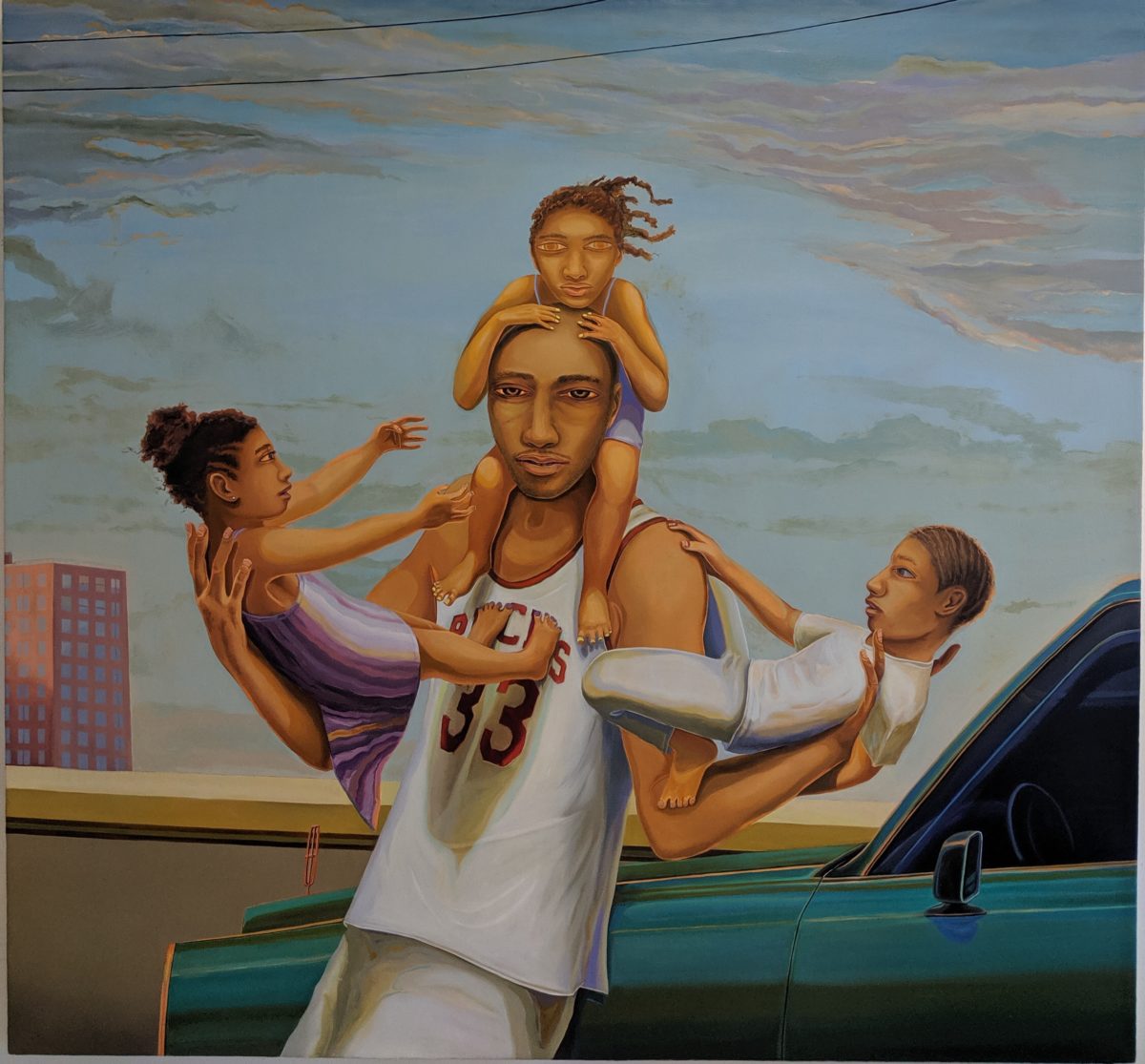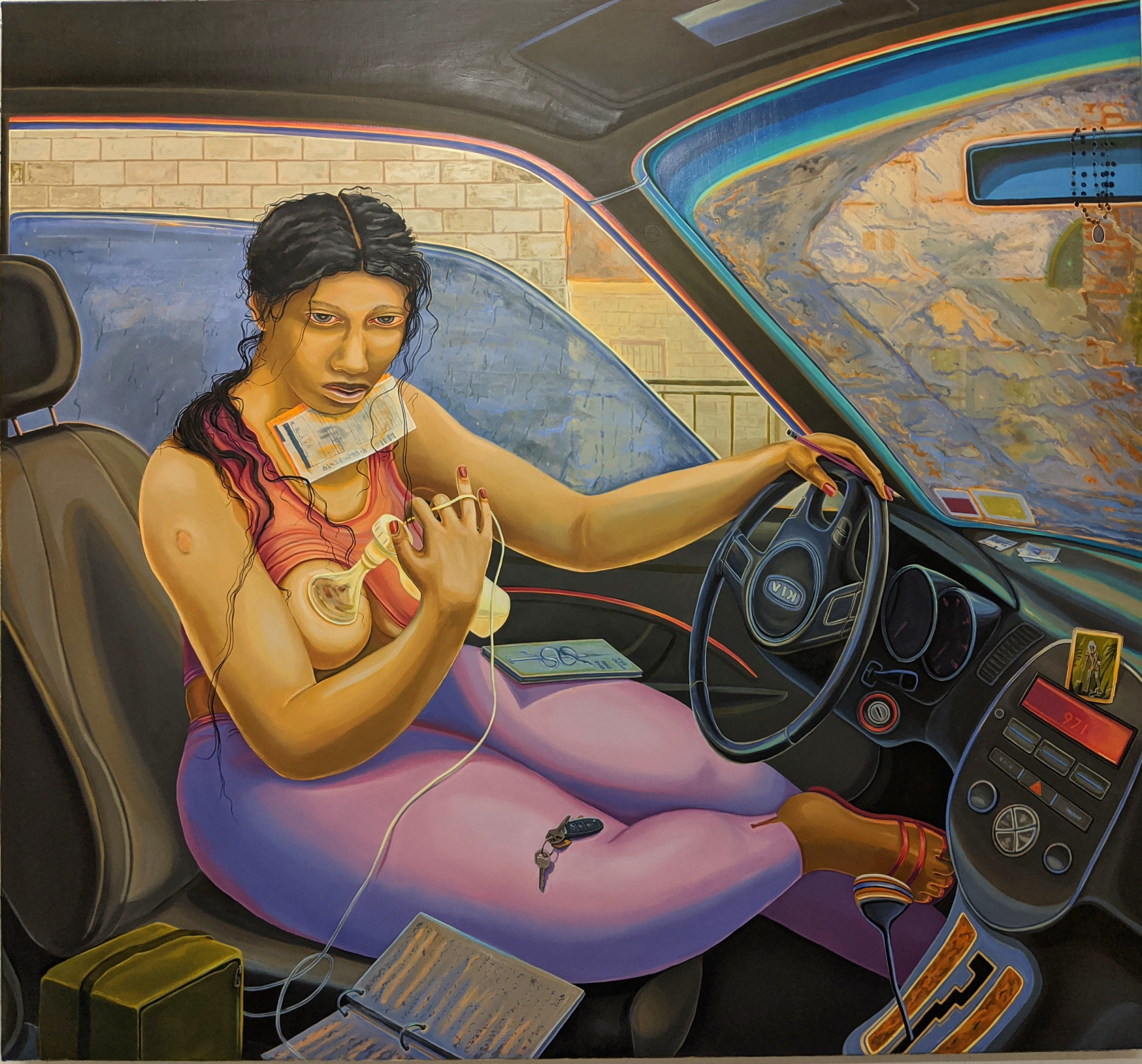
Aaron Gilbert paints heightened everyday scenes, depicting moments of family life and intimate interaction with a surreal edge. His works often suggest at sleep or semi-conscious states, as faces leave ghost-like trails in their wake, and colours seems to vibrate from the canvas. But his figures are highly present, often painted as though looking straight at the viewer with a piercing sense of familiarity. The artist appears as a subject in his work numerous times, as do relatives and close acquaintances.
Gilbert is interested in elevating the human experience, containing both the reality of “normal life” and the transformational potential of human beings all in one painting. He has a long-held interest in retablos, Mexican devotional paintings which combine the “impulse for making a spiritual or metaphysical object with very personal narratives”. As the Brooklyn-based artist tells me, these paintings consider the world “in a more dynamic way. It’s not an academic discourse, there’s something there that feels more powerful to me. I am interested in things that engage with the metaphysical.”
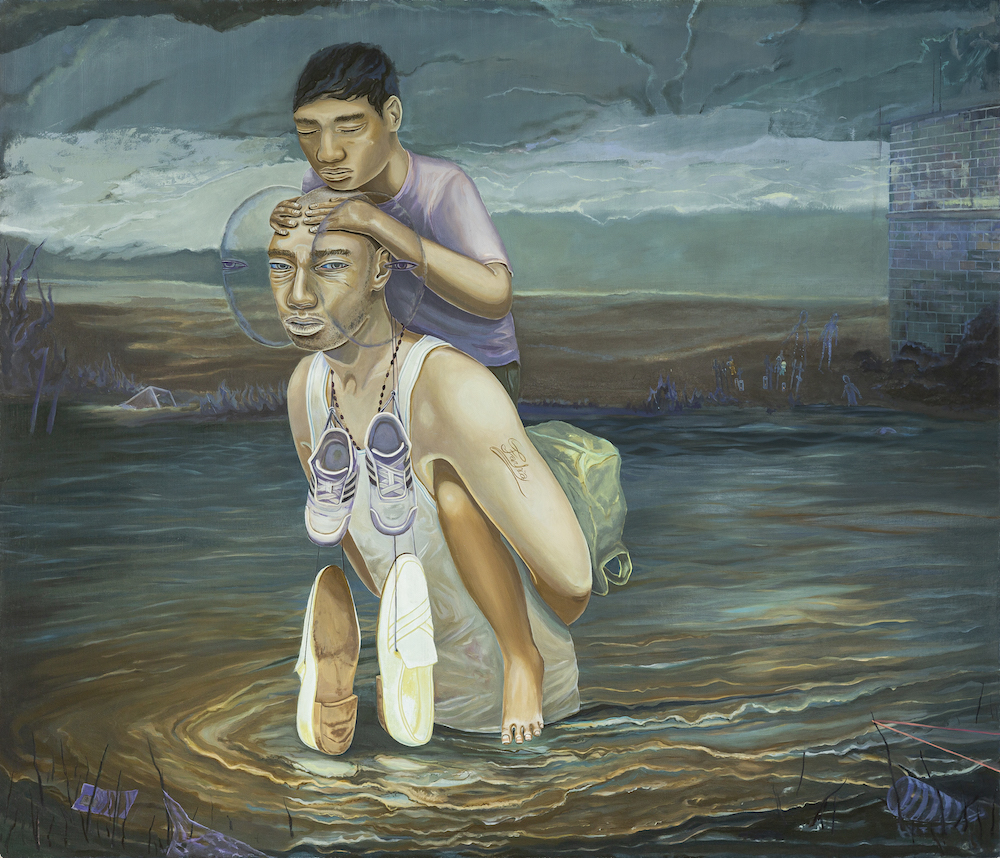
I am really intrigued by the way you create compositions. You depict quite naturalistic scenes, but there are often surreal or unexpected elements within these. Do you take a lot of inspiration from observing moments and interactions in real life?
There have been a lot of times when I have found a moment that’s really stuck with me. I am always interested when something catches my eye and I’m not sure why it mattered. That’s the most exciting thing to listen to and respond to. It’s what I tend to trust the most, when I don’t actually understand why a particular moment had value. Sometimes it might be a really small action or interaction that happens, which feels like it means everything; it might feel jarring or unknown. Other times I will do small sketches with a pencil and the composition works its way out as I’m drawing; I just follow the path. I am always interested in how writers work, especially fiction writers, and how they build characters and settings. That is an interesting parallel for me.
- Solomon / Whirlwind, 2019
“A core thing I think about in life is that none of us really know how powerful we can be”
Your paintings often imply narrative. Do you want the viewer to try and figure out what is going on, or are you more interested in evoking a mood or psychological state? Much of your work drifts into suggested sleep or semi-conscious states.
I think that the mood is the part beyond the story. A while ago I read In Search of the Miraculous by Pyotr Ouspenskii, and while there isn’t any tradition that I’m on 100 percent on board with, there were things I really loved about George Gurdjieff’s teachings in the book. He talks about how many humans go through their entire life in a sleep state, and there is a really intense and focused process of transformation. I really liked the way that was described, and that really impacted how I view and move through the world. A core thing I think about in life is that none of us really know how powerful we can be, and everybody has this possibility for profound transformation.
In a way, the work honours everyone’s potential. I am always trying to be less messy and pathetic than I was the day before! There is a lightness of touch to the work too, but I want to lead a meaningful life and this is me trying to unlock that. The dream would be to have the work be a roadmap so that other people could find a way to do that too.

I have read before that your works are created from many different layers, and that you make a lot of edits as you paint. Is this still how you work?
Yes. There are a lot of layers to the paintings and part of that is to do with finding narrative and compositional elements. There’s maybe five or six layers of paint, and more than anything else that has to do with trying to get all the colours to vibrate in a way that feels right; getting the light right in a way that serves the narrative. I love the idea of colour itself as this abstract thing, where you are literally freezing frequency. The painting emits an energy in the room forever afterwards, and that can be this magical thing. It’s like an instrument and you tune it, and it just resonates. It is beyond language.
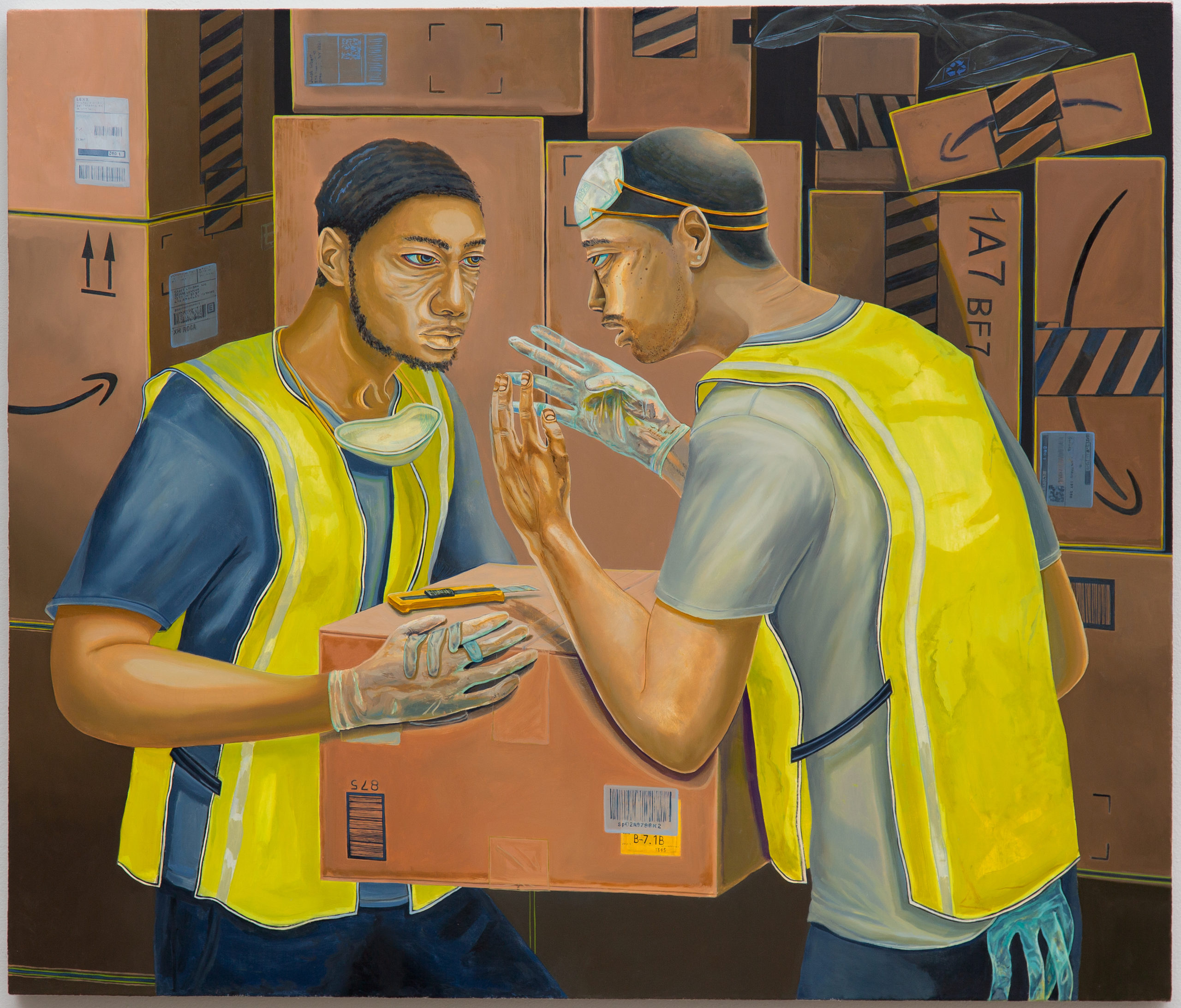
“I love the idea of colour itself as this abstract thing, where you are literally freezing frequency”
You have previously spoken about the influence of devotional paintings on your work. Are there any examples that made a big impact on you early on, or that you keep returning to?
I think it’s devotional paintings and devotional objects too. There is a certain magic to them; they engage with the world in a more dynamic way. It’s not an academic discourse, there’s something there that feels more powerful to me. I am interested in things that engage with the metaphysical, where you’re trying to build a portal. It could even be a portal to a different person.
I am really interested in retablos, Mexican devotional paintings, because they combine that impulse for making a spiritual or metaphysical object with very personal narratives. They collide the two: somebody got stabbed and survived; or someone was cheating on her husband and almost got caught but then wasn’t. It’s these very real narratives, taking who we actually are and the world we actually have, and at the same time, within the same piece, trying to connect it to this mythological tradition that points towards where we find meaning in the world and in how we live our lives. I love how these paintings try to reconcile those two things at the same time. Their ambition is to connect you with the centre of the universe, and there are a lot of things that happen in the execution of those objects that makes them resonate in a different way and feel more magical. There was more at stake for the artist.
With a lot of painting now it’s much quicker, and it is a different set of ambitions. Early on I was drawn to painting as a medium, because of this other thing, which really stuck with me. And I also wanted to avoid that complete disconnect with normal life.
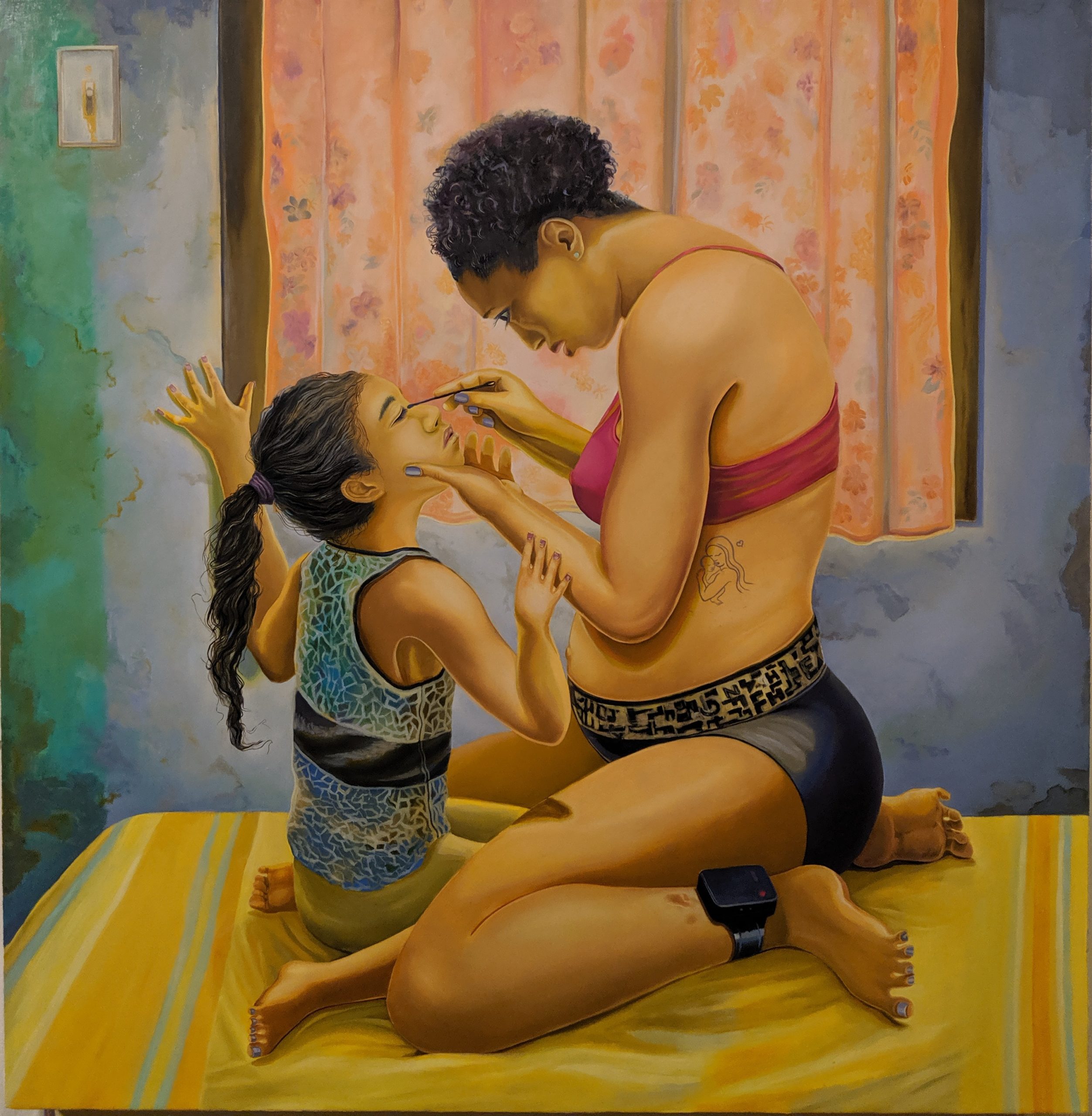
The belief in a higher human purpose, which often comes into your work, is something many people find in religion. Within more secular communities, do you feel this element is missing?
I think that, more often than not, religion historically served the state in ways that were negative. It’s understandably hard for people to stomach the idea of returning to that, but I think what’s lacking now is a holistic community involvement. A lot of the social movements are centred around people in their mid-twenties to mid-thirties. In the past there was this central organising structure, people would all meet once a week, and you would have children and grandparents involved. When you lose that sense of community you lose a lot of wisdom and you lose discipline. I think it’s important to look at those things and see what value they had, without having to also have all the negative stuff. It’s always good to look at what we’re lacking right now and what we can find in the past.
“I am interested in things that engage with the metaphysical, where you’re trying to build a portal”
Right now, we do have an opportunity to decide what to focus on and what to amplify. In my mind, the most important things to focus on are defunding and demilitarising the police; an abolition of the current prison system and mass incarceration; and freeing all non-violent drug offenders. Those three things absolutely need to be focused on, and the focus needs to be maintained on that because lots of other things are going to be put in place: like, hey, we just did this for you, you should feel better now. Those things are just bandages, that aren’t correcting this huge gaping chest wound.
